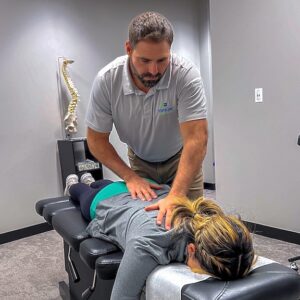Sciatica is often an excruciating condition characterized by pain, numbness, or tingling that radiates along the sciatic nerve, running from the lower back through the hips and down each leg. This ailment affects countless individuals worldwide, impacting their daily lives and activities. While there are various treatments available, chiropractic care has gained recognition as a potential solution for managing sciatica discomfort.
Chiropractic care focuses on the spine’s alignment and its impact on the body’s overall function. Many people suffering from sciatica pain seek relief through chiropractic therapy, considering its non-invasive nature and focus on natural healing. However, the question remains: when is chiropractic care a viable solution for sciatica pain?
Understanding Sciatica and Its Triggers
Sciatica pain often originates from a compressed or irritated sciatic nerve. This compression can stem from various factors, including:
Anatomy of the Sciatic Nerve: The sciatic nerve, deriving from nerve roots in the lower spine, is an intricate network responsible for transmitting sensory and motor signals to and from the lower limbs. Any disruption along its path, from the spine to the feet, can lead to a variety of symptoms associated with sciatica. It comprises several nerve roots originating from the lumbar and sacral regions of the spine, intertwining to form the sciatic nerve, making it susceptible to various sources of irritation or compression.
Herniated or Bulging Discs: When a disc herniates, the gel-like inner core protrudes through the tough outer ring, irritating or compressing nearby nerves, including the sciatic nerve. Bulging discs occur when the discs extend beyond their normal boundaries, exerting pressure on adjacent structures. This pressure can cause chemical irritation and inflammation, impacting the nerve and resulting in sciatic pain. Factors like genetics, age-related changes, or sudden trauma can contribute to disc herniation or bulging.
Spinal Stenosis: As the body ages, the spine undergoes degenerative changes. This can include the thickening of ligaments and the formation of bone spurs, leading to spinal stenosis—a narrowing of the spinal canal or nerve root canals. This constriction can affect nerve roots, including the sciatic nerve, resulting in compression and subsequent sciatica symptoms. It’s often a progressive condition that worsens over time.
Bone Spurs and Growth: Bone spurs, or osteophytes, can form due to osteoarthritis or wear-and-tear on the spine. These bony outgrowths might develop on vertebrae or spinal joints, encroaching on the space occupied by the sciatic nerve. Over time, these growths can cause nerve compression or irritation, leading to sciatic pain and discomfort.
Piriformis Syndrome: The piriformis muscle, responsible for hip rotation, sits adjacent to the sciatic nerve. In some individuals, the sciatic nerve runs through or under the piriformis muscle. When this muscle tightens or spasms due to injury, strain, or anatomical variations, it can compress the sciatic nerve, resulting in symptoms similar to sciatica. This syndrome can be challenging to diagnose and may require careful examination to differentiate from other causes of sciatic pain.
Degenerative Disc Disease: Over time, the spinal discs lose water content and elasticity, becoming less effective as shock absorbers. Degeneration can cause discs to collapse or herniate more easily, leading to compression or irritation of the adjacent nerves, including the sciatic nerve. Age-related wear and tear, repetitive stress, or genetic predispositions can contribute to this degenerative process.
Spinal Misalignment: Misalignments or subluxations in the spine can occur due to various factors, such as poor posture, trauma, or imbalanced muscle use. These misalignments may disrupt the normal function of the spine and irritate the nerve roots that make up the sciatic nerve, potentially leading to sciatica symptoms like pain, tingling, or weakness in the lower back and legs.
Trauma and Injuries: Accidents, falls, or sports-related injuries can directly impact the spine or surrounding structures. These traumas can lead to fractures, dislocations, or soft tissue injuries that might affect the sciatic nerve directly or indirectly, causing inflammation, compression, or irritation. Identifying and treating such injuries promptly is crucial in preventing long-term nerve damage and subsequent sciatica symptoms.
Sacroiliac Joint Dysfunction: The sacroiliac joint (SI joint) plays a pivotal role in transmitting forces between the spine and the pelvis. Dysfunction in this joint can arise due to various reasons such as injury, pregnancy-related changes, arthritis, or even hormonal imbalances. When this joint is compromised, it can cause irritation or inflammation of the nearby sciatic nerve roots. Sacroiliac joint dysfunction often manifests as pain in the lower back, buttocks, and thighs, mimicking symptoms associated with sciatica. Addressing this dysfunction involves therapeutic approaches that aim to stabilize the joint, reduce inflammation, and restore proper function through targeted exercises and manual therapies.
Muscle Imbalances and Postural Issues: Muscle imbalances within the musculature supporting the spine and pelvis can significantly impact spinal alignment. Weakness or tightness in specific muscle groups, such as the hip flexors, hamstrings, or core muscles, can create unequal forces on the spine, leading to misalignments that affect the sciatic nerve. Poor posture, whether due to prolonged sitting, standing, or improper body mechanics, can further exacerbate these imbalances, potentially contributing to sciatica. Corrective exercises, stretching routines, and ergonomic adjustments are often employed to address these imbalances and promote proper spinal alignment.
Inflammatory Conditions: Inflammatory disorders affecting the spine, such as rheumatoid arthritis, ankylosing spondylitis, or infections of the spine (such as discitis), can trigger localized inflammation. Inflammation in the spinal structures or surrounding tissues can directly impinge upon the sciatic nerve, amplifying its sensitivity and contributing to the development or exacerbation of sciatica symptoms. Managing these inflammatory conditions often involves a multifaceted approach, including medication to control inflammation, physical therapy, and lifestyle modifications to mitigate the impact on the spine and nerves.
Psychosocial Factors: The impact of psychosocial factors, including stress, anxiety, depression, and coping mechanisms, can significantly influence the perception and management of sciatic pain. Chronic stress can lead to heightened muscle tension and exacerbate existing pain, amplifying the experience of sciatica. Furthermore, mental health conditions can alter pain perception and tolerance, affecting how individuals cope with and manage their symptoms. Incorporating stress-relief techniques, mindfulness practices, and psychological support into treatment plans can complement physical therapies and aid in improving overall well-being while managing sciatica.
Genetic Predisposition: Genetic factors can predispose individuals to structural vulnerabilities in the spine or connective tissues, increasing the likelihood of developing conditions associated with sciatica. Inherited traits may contribute to spinal abnormalities, such as malformed vertebrae, or influence the resilience of spinal discs to degeneration or injury. While genetics play a role in susceptibility, lifestyle modifications, proper ergonomics, and proactive management strategies can help mitigate the impact of genetic predispositions on the development or severity of sciatica.
How Chiropractic Care Addresses Sciatica Pain
Chiropractic care aims to alleviate sciatica pain by realigning the spine, reducing pressure on the affected nerves. Skilled chiropractors use manual adjustments, spinal manipulation, and other techniques to restore proper spinal alignment. These adjustments can help alleviate the underlying causes of sciatica, providing relief from pain and discomfort.
Chiropractic adjustments for sciatica pain primarily target the affected area, such as the lower back or hips. Through gentle, precise movements, chiropractors work to improve spinal function, reduce inflammation, and promote the body’s natural healing process.
Determining the Suitability of Chiropractic Care for Sciatica Pain
The suitability of chiropractic care for sciatica pain varies from person to person. Factors such as the cause and severity of the condition, the individual’s overall health, and their response to previous treatments play crucial roles in determining the effectiveness of chiropractic care.
It’s essential to consult with a qualified chiropractor to assess whether chiropractic care is a viable solution for your sciatica pain. Chiropractors conduct thorough evaluations, including physical examinations and possibly imaging tests, to create personalized treatment plans tailored to each patient’s needs.
Finding a Trusted Chiropractor Near You
Credentials and Qualifications: Look for a chiropractor who has completed a Doctor of Chiropractic (DC) degree from an accredited institution. Check if they are board-certified and hold relevant licenses and certifications. This not only ensures their professional training but also demonstrates their commitment to continuing education, staying updated with the latest advancements in chiropractic care, and adhering to ethical standards set by regulatory bodies.
Experience and Specialization: Consider the chiropractor’s experience in treating conditions similar to yours, especially sciatica pain. Inquire about the number of years they have been practicing and any specific cases or successes related to sciatica treatment. Some chiropractors might have further education or certifications in specialized areas such as sports injuries, pediatric care, or geriatrics, which can indicate a higher level of expertise in those fields.
Referrals and Recommendations: Seek recommendations from a diverse range of sources. Ask friends, family, or coworkers who have had positive experiences with chiropractors. Additionally, consult healthcare professionals such as your primary care physician or physical therapist, as they often have insights into reputable chiropractors based on patient feedback.
Initial Consultation and Communication: Arrange an initial consultation with the chiropractor. Evaluate their communication style, how they listen to your concerns, and whether they take the time to explain treatment options clearly and comprehensively. A good chiropractor will prioritize patient education, empowering you with knowledge about your condition and the proposed treatment plan.
Clean and Professional Environment: When visiting the chiropractic clinic, assess its cleanliness, organization, and professionalism. A welcoming and hygienic clinic environment signifies attention to detail and patient care. Pay attention to how the staff interact with patients and whether they maintain a respectful and supportive atmosphere.
Technology and Facilities: Check if the clinic utilizes modern equipment and technology. Advanced tools such as digital X-rays, computer-assisted adjustments, or therapeutic devices can enhance the accuracy of diagnoses and effectiveness of treatments. A well-equipped clinic with updated facilities may indicate a commitment to delivering high-quality care.
Cost and Insurance Coverage: Inquire about the cost of treatments and whether the chiropractor accepts your insurance. Understand the payment options available, including any out-of-pocket expenses or co-pays. Additionally, ask about the frequency and duration of treatments needed and any potential package deals or discounts for multiple sessions.
Gut Feeling and Trust: Trust your instincts when evaluating a chiropractor. Consider how comfortable and confident you feel in their presence. A trusting relationship with your chiropractor is crucial for successful treatment outcomes. Factors such as empathy, respect, and genuine concern for your well-being contribute significantly to your overall satisfaction with the care provided.
If you’re considering chiropractic near me for sciatica pain, finding a trusted chiropractor near you is crucial. Websites like Evolve Chiropractic of Freeport can help you locate qualified chiropractors in your area. It’s essential to research and read reviews to ensure you choose a reputable practitioner who can provide the care and expertise you need. Remember, the key to effective sciatica management lies in understanding your options and collaborating with healthcare professionals to find the best course of action for your well-being.
1 W Stephenson St, Freeport, IL 61032
(815) 616-8284
https://myevolvechiropractor.com/chiropractor-in-freeport-il





